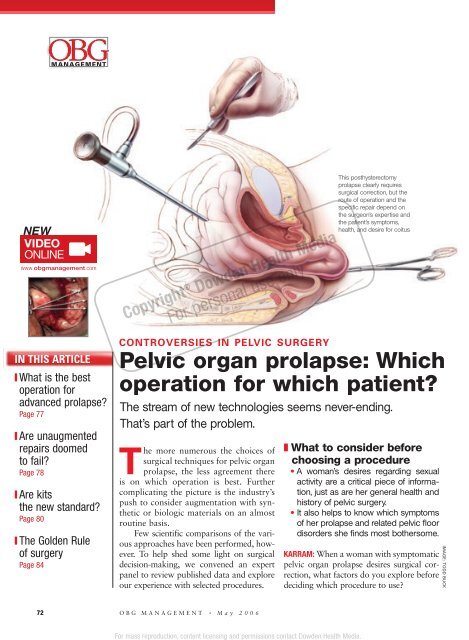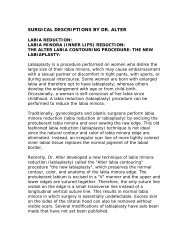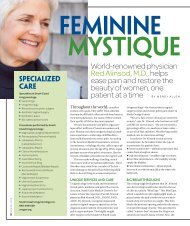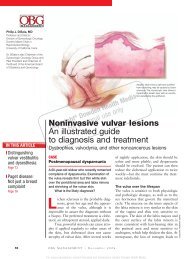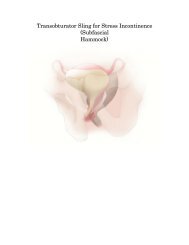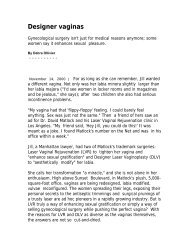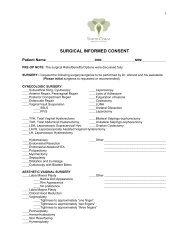Pelvic organ prolapse: Which operation for which ... - Urogyn.org
Pelvic organ prolapse: Which operation for which ... - Urogyn.org
Pelvic organ prolapse: Which operation for which ... - Urogyn.org
Create successful ePaper yourself
Turn your PDF publications into a flip-book with our unique Google optimized e-Paper software.
For mass reproduction, content licensing and permissions contact Dowden Health Media.<br />
OBG<br />
MANAGEMENT<br />
NEW<br />
VIDEO<br />
ONLINE<br />
www.obgmanagement.com<br />
Copyright ® Dowden Health Media<br />
For personal use only<br />
This posthysterectomy<br />
<strong>prolapse</strong> clearly requires<br />
surgical correction, but the<br />
route of <strong>operation</strong> and the<br />
specific repair depend on<br />
the surgeon’s expertise and<br />
the patient’s symptoms,<br />
health, and desire <strong>for</strong> coitus<br />
IN THIS ARTICLE<br />
❙ What is the best<br />
<strong>operation</strong> <strong>for</strong><br />
advanced <strong>prolapse</strong>?<br />
Page 77<br />
❙ Are unaugmented<br />
repairs doomed<br />
to fail?<br />
Page 78<br />
❙ Are kits<br />
the new standard?<br />
Page 80<br />
❙ The Golden Rule<br />
of surgery<br />
Page 84<br />
CONTROVERSIES IN PELVIC SURGERY<br />
<strong>Pelvic</strong> <strong><strong>org</strong>an</strong> <strong>prolapse</strong>: <strong>Which</strong><br />
<strong>operation</strong> <strong>for</strong> <strong>which</strong> patient?<br />
The stream of new technologies seems never-ending.<br />
That’s part of the problem.<br />
The more numerous the choices of<br />
surgical techniques <strong>for</strong> pelvic <strong><strong>org</strong>an</strong><br />
<strong>prolapse</strong>, the less agreement there<br />
is on <strong>which</strong> <strong>operation</strong> is best. Further<br />
complicating the picture is the industry’s<br />
push to consider augmentation with synthetic<br />
or biologic materials on an almost<br />
routine basis.<br />
Few scientific comparisons of the various<br />
approaches have been per<strong>for</strong>med, however.<br />
To help shed some light on surgical<br />
decision-making, we convened an expert<br />
panel to review published data and explore<br />
our experience with selected procedures.<br />
❚ What to consider be<strong>for</strong>e<br />
choosing a procedure<br />
• A woman’s desires regarding sexual<br />
activity are a critical piece of in<strong>for</strong>mation,<br />
just as are her general health and<br />
history of pelvic surgery.<br />
• It also helps to know <strong>which</strong> symptoms<br />
of her <strong>prolapse</strong> and related pelvic floor<br />
disorders she finds most bothersome.<br />
KARRAM: When a woman with symptomatic<br />
pelvic <strong><strong>org</strong>an</strong> <strong>prolapse</strong> desires surgical correction,<br />
what factors do you explore be<strong>for</strong>e<br />
deciding <strong>which</strong> procedure to use?<br />
IMAGE: TODD BUCK<br />
72 OBG MANAGEMENT • May 2006
BRUBAKER: I make an ef<strong>for</strong>t to determine<br />
the woman’s readiness to undergo surgery<br />
and her expectations <strong>for</strong> it, as well as any<br />
concomitant pelvic floor or medical/surgical<br />
conditions.<br />
Other important factors that I consider<br />
include her pelvic surgical history—<br />
specifically, whether she has undergone<br />
earlier continence and/or <strong>prolapse</strong> repairs<br />
—and the presence of any materials in the<br />
proposed surgical site, especially <strong>for</strong>eign<br />
bodies that may limit dissection planes or<br />
have eroded into pelvic viscera.<br />
I also consider her desire (or lack of it)<br />
<strong>for</strong> sexual activity, and her preferred route<br />
of surgical access.<br />
Patient’s lifestyle should sway<br />
surgical decision<br />
PARAISO: I take into account her age and<br />
stage of <strong>prolapse</strong>; vaginal length; innervation<br />
of the pelvic floor; hormonal status;<br />
desire <strong>for</strong> uterine preservation and coitus;<br />
symptoms of sexual, urinary, or bowel dysfunction;<br />
and any comorbidities that influence<br />
her eligibility <strong>for</strong> anesthesia or chronically<br />
increase intra-abdominal pressure.<br />
Connective tissue disorders are also important,<br />
as are any coexisting medical conditions<br />
that impede healing.<br />
Lifestyle has an impact, too, especially<br />
if she regularly per<strong>for</strong>ms heavy manual<br />
labor.<br />
After assessing the patient’s history<br />
and per<strong>for</strong>ming an examination, I target<br />
the <strong>prolapse</strong> and functional symptoms and<br />
correlating anatomic defects that exacerbate<br />
her quality of life. I tailor her surgical<br />
therapy in order to correct her symptoms<br />
and minimize compensatory defects and de<br />
novo dysfunction.<br />
Ask her to prioritize her complaints<br />
SHULL: I have the patient list her complaints<br />
in order of their severity and impact on her<br />
lifestyle.<br />
Next, I complete a detailed pelvic<br />
exam, including use of a mirror to demonstrate<br />
the findings to her. If appropriate, I<br />
test bladder or bowel function.<br />
At that point, we discuss what I think<br />
are appropriate options, although in some<br />
situations I may not be able to treat all her<br />
complaints with equal success.<br />
KARRAM: I think prioritizing the patient’s<br />
complaints is a good idea. My <strong>for</strong>emost aim<br />
is to determine what the woman is most<br />
bothered by. If it is <strong>prolapse</strong> symptoms such<br />
as pressure and tissue protrusion, with no<br />
functional derangements, I try to ensure<br />
that my surgical repair provides durable<br />
support but does not create de novo<br />
derangements such as stress incontinence.<br />
So, <strong>for</strong> example, I try to determine whether<br />
she has preexisting stress incontinence that<br />
is masked by the <strong>prolapse</strong>.<br />
Correlation between <strong>prolapse</strong><br />
and dysfunction can be weak<br />
Obviously, if the patient has many functional<br />
derangements associated with the<br />
<strong>prolapse</strong> symptoms, the preoperative consultation<br />
becomes much more complicated.<br />
Although the complexity may not<br />
change my surgical approach, I think it is<br />
important <strong>for</strong> the patient to understand<br />
that the correlation between anatomic<br />
OUR<br />
EXPERT PANELISTS<br />
❚ Moderator Mickey Karram, MD, Director<br />
of <strong>Urogyn</strong>ecology, Good Samaritan Hospital,<br />
Cincinnati, and Professor of Obstetrics and<br />
Gynecology, University of Cincinnati.<br />
❚ Linda Brubaker, MD, MS, Assistant Dean<br />
of Clinical and Translational Research, and<br />
Professor and Director, Division of Female <strong>Pelvic</strong><br />
Medicine and Reconstructive <strong>Pelvic</strong> Surgery,<br />
Departments of Obstetrics & Gynecology and<br />
Urology, Loyola University Health System,<br />
Chicago.<br />
❚ Marie Fidela Paraiso, MD, Co-Director<br />
of Female <strong>Pelvic</strong> Medicine and Reconstructive<br />
Surgery, Department of Obstetrics and<br />
Gynecology and the Urological Institute,<br />
The Cleveland Clinic, Cleveland, Ohio.<br />
❚ Bob L. Shull, MD, Vice Chairman,<br />
Department of Obstetrics and Gynecology, and<br />
Chief, Section of Female <strong>Pelvic</strong> Medicine and<br />
<strong>Pelvic</strong> Reconstructive Surgery, Scott & White<br />
Health Care System, Temple, Tex.<br />
FAST TRACK<br />
“My <strong>for</strong>emost aim<br />
is to determine<br />
what the woman is<br />
most bothered by”<br />
—Mickey Karram, MD<br />
www.obgmanagement.com May 2006 • OBG MANAGEMENT 73
▲<br />
<strong>Pelvic</strong> <strong><strong>org</strong>an</strong> <strong>prolapse</strong>: <strong>Which</strong> <strong>operation</strong> <strong>for</strong> <strong>which</strong> patient?<br />
FAST TRACK<br />
“I probably<br />
per<strong>for</strong>m 98%<br />
of reconstructive<br />
cases<br />
transvaginally”<br />
—Bob L. Shull, MD<br />
descent and the functional derangement<br />
may not be very good.<br />
As previously mentioned, I make a<br />
point to ask about sexual function. If the<br />
woman is elderly and has no intention of<br />
being sexually active again, I may consider<br />
a very tight or obliterative repair because<br />
these are much less invasive than conventional<br />
repairs.<br />
❚ Is one surgical route<br />
superior?<br />
• There is no consensus among experts<br />
as to the preferred route of surgery <strong>for</strong><br />
advanced pelvic <strong><strong>org</strong>an</strong> <strong>prolapse</strong>.<br />
KARRAM: Numerous vaginal, abdominal,<br />
and laparoscopic procedures have been<br />
described. <strong>Which</strong> route do you prefer?<br />
BRUBAKER: I don’t prefer any laparoscopic<br />
procedures, but I am flexible about vaginal<br />
or abdominal approaches.<br />
Among vaginal procedures, I prefer<br />
uterosacral suspension at the time of hysterectomy,<br />
or the Michigan modification of<br />
sacrospinous ligament suspension when the<br />
patient has already undergone hysterectomy.<br />
As <strong>for</strong> abdominal procedures, I prefer<br />
sacrocolpopexy with Mersilene mesh.<br />
In my hands, these reconstructive procedures<br />
give predictable results that allow<br />
me to appropriately counsel patients preoperatively.<br />
KARRAM: Why do you dislike the laparoscopic<br />
approach?<br />
BRUBAKER: It is not a matter of “dislike,”<br />
but a matter of getting the most reliable<br />
result <strong>for</strong> my patient. When scientific evidence<br />
from well-done clinical trials<br />
demonstrates the equivalency of laparoscopic<br />
procedures, I fully anticipate incorporating<br />
them into my practice. Similarly,<br />
the novel use of the robot may be useful in<br />
reconstructive pelvic surgery.<br />
Laparoscopic repair can produce<br />
good results in the right hands<br />
PARAISO: I prefer the laparoscopic and<br />
vaginal routes. In fact, I have converted<br />
most abdominal procedures to laparoscopic<br />
access. I have nearly 10 years of experience<br />
with laparoscopic sacrocolpopexy,<br />
with excellent success.<br />
My colleagues and I did a cohort study<br />
that showed equal cure rates <strong>for</strong> this procedure,<br />
compared with open sacrocolpopexy.<br />
1 I also have had great success<br />
with the vaginal route when per<strong>for</strong>ming<br />
uterosacral vaginal vault suspensions.<br />
Patients are referred to me or seek me<br />
out specifically <strong>for</strong> minimally invasive procedures,<br />
so the majority of <strong>operation</strong>s I<br />
per<strong>for</strong>m are laparoscopic procedures with<br />
or without vaginal procedures, or vaginal<br />
procedures alone.<br />
Vaginal approach is possible<br />
in high percentage of cases<br />
SHULL: I probably per<strong>for</strong>m 98% of reconstructive<br />
cases transvaginally. If the<br />
woman has urinary incontinence as well as<br />
<strong>prolapse</strong>, I usually per<strong>for</strong>m a midurethral<br />
sling procedure along with the repair.<br />
KARRAM: I do roughly 90% of <strong>prolapse</strong><br />
repairs transvaginally. For the last 6 to 8<br />
years, my colleagues and I have utilized a<br />
high uterosacral vaginal vault suspension<br />
to support the vaginal cuff. We do so in<br />
conjunction with a modified internal<br />
McCall-type procedure to obliterate the<br />
cul-de-sac. We also do site-specific anterior<br />
and posterior colporrhaphy as needed, and<br />
a synthetic midurethral sling if the patient<br />
has stress incontinence.<br />
In very young patients (under 35 years<br />
of age) or those who have substantial recurrent<br />
<strong>prolapse</strong> or a <strong>prolapse</strong>d <strong>for</strong>eshortened<br />
vagina, we consider abdominal sacrocolpopexy<br />
with synthetic mesh as our primary<br />
<strong>operation</strong>. In such cases, we commonly<br />
per<strong>for</strong>m retropubic repair <strong>for</strong><br />
incontinence and paravaginal defects, as<br />
well as posterior repair and perineorrhaphy.<br />
I have very little experience with<br />
laparoscopic <strong>prolapse</strong> repairs.<br />
Abdominal sacrocolpopexy<br />
is anatomically superior<br />
KARRAM: Dr. Brubaker, you just chaired a<br />
consensus panel on pelvic <strong><strong>org</strong>an</strong> <strong>prolapse</strong><br />
74 OBG MANAGEMENT • May 2006
<strong>Pelvic</strong> <strong><strong>org</strong>an</strong> <strong>prolapse</strong>: <strong>Which</strong> <strong>operation</strong> <strong>for</strong> <strong>which</strong> patient?<br />
▲<br />
<strong>for</strong> the International Consultation on<br />
Incontinence. This panel reviewed all the<br />
published literature on the topic. What conclusions<br />
did it reach about the various surgical<br />
procedures <strong>for</strong> pelvic <strong><strong>org</strong>an</strong> <strong>prolapse</strong>?<br />
BRUBAKER: The “big picture” findings<br />
were that abdominal sacrocolpopexy is<br />
anatomically superior to the other procedures,<br />
but carries a higher rate of shortterm<br />
morbidity than transvaginal procedures.<br />
Since that panel, a review on<br />
sacrocolpopexy by Nygaard et al 2 highlighted<br />
the strengths, weaknesses, and<br />
uncertainties of this procedure.<br />
We found no indications <strong>for</strong> routine<br />
use of ancillary materials when per<strong>for</strong>ming<br />
primary transvaginal repairs.<br />
❚ What is the best <strong>operation</strong><br />
<strong>for</strong> advanced <strong>prolapse</strong>?<br />
• The best procedure depends on the<br />
patient’s health, type and extent of<br />
<strong>prolapse</strong>, and sexual activity. Surgical<br />
history also is key.<br />
KARRAM: Let’s say a 60-year-old woman<br />
with advanced, symptomatic, primary<br />
pelvic <strong><strong>org</strong>an</strong> <strong>prolapse</strong> presents to you <strong>for</strong><br />
surgical treatment. The findings include<br />
posthysterectomy vaginal vault <strong>prolapse</strong><br />
with a large cystocele, large rectocele, and<br />
an enterocele. What <strong>operation</strong> would you<br />
per<strong>for</strong>m?<br />
SHULL: I would probably elect a transvaginal<br />
approach using the uterosacral ligaments<br />
to suspend the cuff and reapproximate<br />
the connective tissue of the anterior<br />
and posterior compartments. My colleagues<br />
and I described this technique. 3<br />
PARAISO: If the patient is physically and sexually<br />
active and willing to undergo synthetic<br />
graft implantation, I would per<strong>for</strong>m<br />
laparoscopic sacrocolpopexy, especially if<br />
previous transvaginal apical suspension has<br />
failed, if she has a <strong>for</strong>eshortened vagina, or<br />
if she has denervation of her pelvic floor.<br />
Check <strong>for</strong> defecatory dysfunction<br />
If it is necessary <strong>for</strong> her to manually digitate<br />
her vagina or splint her perineum to<br />
defecate, I would per<strong>for</strong>m a rectocele<br />
repair and perineorrhaphy.<br />
If she is not a candidate <strong>for</strong> laparoscopic<br />
or abdominal surgery because of a<br />
history of multiple procedures <strong>for</strong><br />
inflammatory bowel disease or severe<br />
adhesions, has not had a previous transvaginal<br />
apical suspension, and has intact<br />
pelvic floor innervation, I would per<strong>for</strong>m<br />
either uterosacral vaginal vault suspension<br />
or sacrospinous ligament suspension<br />
with concomitant anterior and posterior<br />
repair.<br />
I would consider offering this patient a<br />
tension-free vaginal mesh “kit” procedure<br />
(with synthetic mesh) if she:<br />
• has failed previous vaginal procedures,<br />
• has multiple comorbidities,<br />
• is not a candidate <strong>for</strong> laparoscopic or<br />
abdominal surgery,<br />
• desires to remain sexually active, and<br />
• is willing to use and has no contraindications<br />
to intravaginal estrogen therapy.<br />
If she does not wish to remain sexually<br />
active and is not a good operative candidate,<br />
I would offer colpectomy and<br />
colpocleisis with perineorrhaphy.<br />
❚ <strong>Which</strong> circumstances<br />
pose special challenges?<br />
• Apical suspension is a critical factor in<br />
success and durability of the surgery.<br />
KARRAM: <strong>Which</strong> segment of the pelvic floor<br />
do you find most challenging when correcting<br />
advanced pelvic <strong><strong>org</strong>an</strong> <strong>prolapse</strong>?<br />
SHULL: My colleagues and I have reported<br />
our experience with several techniques of<br />
vaginal repair <strong>for</strong> <strong>prolapse</strong>, including<br />
sacrospinous ligament suspension, iliococcygeus<br />
fascial suspension, and<br />
uterosacral ligament suspension. When<br />
we analyzed specific sites in the vagina,<br />
the anterior compartment always had the<br />
greatest percentage of persistent or recurrent<br />
loss of support.<br />
Our best success has been with<br />
uterosacral ligament suspension.<br />
C O N T I N U E D<br />
FAST TRACK<br />
“If you get<br />
the apex up solidly,<br />
you’re usually<br />
home free”<br />
—Linda Brubaker, MD<br />
www.obgmanagement.com May 2006 • OBG MANAGEMENT 77
▲<br />
<strong>Pelvic</strong> <strong><strong>org</strong>an</strong> <strong>prolapse</strong>:<br />
<strong>Which</strong> <strong>operation</strong> <strong>for</strong> <strong>which</strong> patient?<br />
Vaginal apex is key to success<br />
PARAISO: I also find the anterior segment challenging.<br />
However, if I am able to suspend the<br />
vaginal apex well, management of the anterior<br />
vaginal wall is less challenging. The anterior<br />
wall fails because treatment of high<br />
transverse cystoceles and anterior enteroceles<br />
(less commonly seen) depends on the apical<br />
suspension. Many of these defects go untreated<br />
because they are often not detected.<br />
BRUBAKER: I agree with Dr. Paraiso. If you get<br />
the apex up solidly, you’re usually home free.<br />
KARRAM: Yes. If one can get good, high,<br />
durable support to the apex, the other segments<br />
of the pelvic floor are much more likely<br />
to endure.<br />
❚ Are unaugmented repairs<br />
doomed to fail?<br />
• Despite claims to the contrary, re<strong>operation</strong><br />
rates are low <strong>for</strong> most conventional<br />
repairs.<br />
• Surgeons may be tempted to adopt graft<br />
augmentation techniques to keep up with<br />
“Dr. Jones.”<br />
KARRAM: As you know, there has been a<br />
recent push to consider augmenting most<br />
pelvic <strong><strong>org</strong>an</strong> <strong>prolapse</strong> repairs with either<br />
biologic or synthetic mesh. This approach is<br />
based on a perception that conventional<br />
repairs without augmentation inevitably<br />
will fail. Do you agree with this perception?<br />
SHULL: Not based on my own experience.<br />
Mesh has been effectively and safely used <strong>for</strong><br />
midurethral slings and abdominal sacrocolpopexies,<br />
but there are not enough data on<br />
the use of allografts, xenografts, or meshes to<br />
be able to counsel a patient properly about<br />
their safety, efficacy, or long-term effects.<br />
PARAISO: I agree that this perception is being<br />
promoted, prompting many physicians to<br />
adopt graft augmentation techniques to keep<br />
up with “Dr. Jones” or to offer their patients<br />
“cutting-edge” treatment. Despite the fact that<br />
conventional procedures are often described as<br />
having high failure rates, the re<strong>operation</strong> rates<br />
in most series are low. Nevertheless, augmen-<br />
78 OBG MANAGEMENT • May 2006
▲<br />
<strong>Pelvic</strong> <strong><strong>org</strong>an</strong> <strong>prolapse</strong>: <strong>Which</strong> <strong>operation</strong> <strong>for</strong> <strong>which</strong> patient?<br />
FAST TRACK<br />
“Any <strong>operation</strong><br />
that alters the<br />
vaginal axis will<br />
seriously weaken<br />
the vagina opposite<br />
the distorted axis”<br />
—Mickey Karram, MD<br />
tation with biologic grafts has been widely<br />
adopted without prior investigation or data.<br />
Traditional and site-specific repairs<br />
versus graft augmentation<br />
My colleagues and I just presented a manuscript<br />
on traditional posterior colporrhaphy,<br />
site-specific rectocele repair, and sitespecific<br />
repair with graft augmentation<br />
using a porcine small intestinal submucosa<br />
bioengineered collagen matrix.<br />
The anatomic cure rate was substantially<br />
higher in the traditional and site-specific<br />
groups when compared with the graft augmentation<br />
arm, with cure rates of 86%<br />
and 78% versus 54%, respectively<br />
(P=.02). 4<br />
Currently, my indications <strong>for</strong> a meshaugmented<br />
<strong>prolapse</strong> repair are:<br />
• Nonexistent or suboptimal autologous<br />
tissue<br />
• Need to augment weak or absent<br />
endopelvic tissue<br />
• Connective tissue disorder<br />
• Unavoidable stress on the repair (eg,<br />
chronic lifting, chronic obstructive<br />
pulmonary disease, chronic straining<br />
to defecate, obesity)<br />
• Need to bridge a space such as sacral<br />
colpopexy<br />
• Concern about vaginal length or<br />
caliber<br />
• Denervated pelvic floor<br />
• Recurrent <strong>prolapse</strong><br />
Surgeons should not believe that graft augmentation<br />
compensates <strong>for</strong> surgical mediocrity<br />
or patient risk factors <strong>for</strong> pelvic<br />
<strong><strong>org</strong>an</strong> <strong>prolapse</strong>.<br />
The key to success:<br />
Maintain the vaginal axis<br />
KARRAM: I don’t believe all traditional<br />
repairs are bound to fail. Many factors play<br />
into recurrent <strong>prolapse</strong>. I think most people<br />
overlook the fact that the vagina is very<br />
sensitive to its axis. Any <strong>operation</strong> that<br />
alters the vaginal axis will seriously weaken<br />
the vagina opposite the distorted axis.<br />
For example, we know that<br />
sacrospinous ligament suspension retroverts<br />
the vagina and sets women up <strong>for</strong><br />
recurrence or development of anterior vaginal<br />
wall <strong>prolapse</strong>. Another example is a<br />
Burch colposuspension that anteverts a<br />
portion of the vagina and sets patients up<br />
<strong>for</strong> posterior vaginal wall defects in the<br />
<strong>for</strong>m of a rectocele and enterocele.<br />
Too much simplification<br />
I also think surgeons and device manufacturers<br />
have attempted to simplify what, in<br />
reality, is a very complicated clinical picture.<br />
So many factors are involved in the<br />
identification and appropriate utilization<br />
of support structures <strong>for</strong> a durable <strong>prolapse</strong><br />
repair.<br />
Since Dr. Shull’s popularization of a<br />
high uterosacral suspension, we have had<br />
very good long-term success with transvaginal<br />
vault repair. Also, over time I have<br />
realized that it is possible to mobilize a<br />
substantial amount of durable fascial tissue—<strong>which</strong><br />
is nothing more than the muscular<br />
lining of the vagina—to appropriately<br />
support the anterior and posterior<br />
vaginal walls.<br />
That said, the results are far from perfect.<br />
I would estimate our anatomic failure<br />
rate at 15% to 20% over the long term.<br />
Does augmentation<br />
add complications?<br />
When it comes to mesh, we have to ask: Is<br />
it truly going to increase durability? If it is,<br />
is that going to be at the expense of a new<br />
set of complications such as mesh erosion<br />
or extrusion and dyspareunia?<br />
The only way to answer these questions<br />
is with a randomized trial with longterm<br />
follow-up. At this time, such data are<br />
not available.<br />
❚ Are tension-free repair kits<br />
the wave of the future?<br />
• It’s not yet time to make these kits the<br />
standard, although preliminary data<br />
are promising.<br />
KARRAM: Do you think the synthetic mesh<br />
repairs now being promoted as tensionfree<br />
repairs utilizing numerous industry-<br />
CONTINUED<br />
80 OBG MANAGEMENT • May 2006
▲<br />
<strong>Pelvic</strong> <strong><strong>org</strong>an</strong> <strong>prolapse</strong>: <strong>Which</strong> <strong>operation</strong> <strong>for</strong> <strong>which</strong> patient?<br />
FAST TRACK<br />
“Until trials<br />
are done, we won’t<br />
really know<br />
how the kits with<br />
synthetic mesh<br />
compare with<br />
conventional<br />
repairs”<br />
—Mickey Karram, MD<br />
created “kits” will be the future of <strong>prolapse</strong><br />
repair?<br />
BRUBAKER: I hope not.<br />
KARRAM: At present, I would say the<br />
answer to that question is “no.” However,<br />
I was very reluctant to accept synthetic<br />
midurethral slings, and they have turned<br />
out to be the standard of care.<br />
SHULL: These products are the future <strong>for</strong><br />
surgeons who allow industry to dictate<br />
their practice styles. For those of us who<br />
are more skeptical, we will change only<br />
after there is adequate scientific in<strong>for</strong>mation<br />
to do so.<br />
Though unproven,<br />
kits do have advantages<br />
PARAISO: I agree. Even so, in many ways,<br />
these kits make sense. Operative time is<br />
greatly reduced and incisions are small,<br />
thus offering the advantage of minimally<br />
invasive procedures. Preliminary data at 6<br />
months show excellent anatomic outcomes.<br />
However, the graft extrusion rate is<br />
high with the kit procedures, compared<br />
with existing evidence on synthetic mesh<br />
erosion associated with abdominal and<br />
laparoscopic sacral colpopexy.<br />
In addition, current synthetic materials<br />
are not ideal. Long-term sequelae of transvaginal<br />
implantation of these meshes are<br />
not known. Nor do we have long-term<br />
data on sexual function.<br />
By and large, these procedures are<br />
blind and involve the transobturator and<br />
transgluteal (ischiorectal fossa) spaces—<br />
uncharted waters <strong>for</strong> many gynecologic<br />
surgeons. Further, many gynecologic surgeons<br />
lack extensive training or experience<br />
in sacrospinous ligament suspension, iliococcygeus<br />
fascia suspension, and vaginal<br />
paravaginal defect repair, <strong>which</strong> are prerequisites<br />
<strong>for</strong> the kit procedures.<br />
Matching the kit procedure<br />
to the patient<br />
As <strong>for</strong> patient selection, women <strong>for</strong> whom<br />
previous anterior repair (with or without<br />
biologic graft), paravaginal defect repair,<br />
and apical suspension have failed, and<br />
who continue to have asymptomatic anterior<br />
vaginal wall <strong>prolapse</strong> are the best candidates<br />
<strong>for</strong> anterior kit procedures. The<br />
best candidates <strong>for</strong> posterior and apical<br />
segment kit procedures are women in<br />
whom transvaginal apical suspension has<br />
failed, and who are not suited <strong>for</strong> laparoscopic<br />
or abdominal procedures.<br />
The only impediments to widespread<br />
adoption of these procedures <strong>for</strong> years to<br />
come will be adverse events or technology<br />
so advanced it makes gene modification<br />
possible, rendering surgery obsolete.<br />
KARRAM: I think we need better and<br />
longer follow-up. Most of the surgeons<br />
currently using these procedures are proponents<br />
of the repairs, in my opinion, but<br />
until results from comparative trials<br />
become available, we won’t really know<br />
how they compare to conventional<br />
repairs.<br />
❚ Bringing up<br />
the next generation<br />
• Residents need as much hands-on<br />
experience as possible, including<br />
cadaveric dissections, urodynamic<br />
labs, and urogynecologic clinics—<br />
even virtual-reality models.<br />
KARRAM: How do we best train residents in<br />
the appropriate evaluation and surgical<br />
management of these very common pelvic<br />
floor disorders?<br />
BRUBAKER: Carefully and ethically.<br />
Encourage them to be good consumers of<br />
surgical literature and to resist the urge to<br />
constantly demonstrate the “latest and<br />
greatest” until we have solid evidence.<br />
PARAISO: Residents can learn from discussions<br />
of surgical indications prior to pelvic<br />
reconstructive procedures in <strong>which</strong> they<br />
are involved, attendance at urogynecologic<br />
clinics, urodynamic lab rotations, and<br />
study of urogynecologic learning modules<br />
and current clinical textbooks that focus<br />
on these surgeries.<br />
Given the decrease in resident work<br />
hours, <strong>which</strong> translates to fewer cases,<br />
cadaver labs are also helpful.<br />
C O N T I N U E D<br />
82 OBG MANAGEMENT • May 2006
Expert<br />
Peer<br />
Review<br />
These educators and researchers are among<br />
the experts who help select up-to-date,<br />
accurate, and relevant in<strong>for</strong>mation<br />
<strong>for</strong> every issue, cover-to-cover.<br />
Harold Bivins, MD<br />
Savannah, Ga<br />
Andrew I. Brill, MD<br />
Chicago, Ill<br />
Brian C. Brost, MD<br />
Rochester, Minn<br />
Haywood Brown, MD<br />
Durham, NC<br />
James Burke II, MD<br />
Savannah, Ga<br />
David Byck, MD<br />
Savannah, Ga<br />
Frank Chervenak, MD<br />
New York, NY<br />
William A. Cliby, MD<br />
Rochester, Minn<br />
Alan H. DeCherney, MD<br />
Bethesda, Md<br />
Philip J. DiSaia, MD<br />
Orange, Calif<br />
Patrick Duff, MD<br />
Gainesville, Fla<br />
Abimbola O. Famuyide, MD<br />
Rochester, Minn<br />
Sebastian Faro, MD, PhD<br />
Houston, Tex<br />
John Gebhart, MD<br />
Rochester, Minn<br />
Martin L. Gimovsky, MD<br />
Newark, NJ<br />
Mark H. Glasser, MD<br />
San Rafael, Calif<br />
Amos Grunebaum, MD<br />
New York, NY<br />
Steven Hockstein, MD<br />
New York, NY<br />
Thomas M. Julian, MD<br />
Madison, Wis<br />
Christopher Klingele, MD<br />
Rochester, Minn<br />
Robert Kovac, MD<br />
Atlanta, Ga<br />
Franklin Loffer, MD<br />
Tucson, Ariz<br />
Anthony A. Luciano, MD<br />
New Britain, Conn<br />
Dev Maulik, MD, PhD<br />
Mineola, NY<br />
Ramon V. Meguiar, MD<br />
Savannah, Ga<br />
William H. Parker, MD<br />
Santa Monica, Calif<br />
JoAnn Rosenfeld, MD<br />
Odenton, Md<br />
Amy Rosenman, MD<br />
Santa Monica, Calif<br />
Gerard Roy, MD<br />
New Britain, Conn<br />
Hyagriv Simhan, MD<br />
Pittsburgh, Pa<br />
Anthony R. Scialli, MD<br />
Alexandria, Va<br />
Stephen B. Young, MD<br />
Worcester, Mass<br />
Carl W. Zimmerman, MD<br />
Nashville, Tenn<br />
▲<br />
<strong>Pelvic</strong> <strong><strong>org</strong>an</strong> <strong>prolapse</strong>:<br />
<strong>Which</strong> <strong>operation</strong> <strong>for</strong> <strong>which</strong> patient?<br />
Virtual-reality models are being developed<br />
and will be available this decade.<br />
❚ Golden rule of surgery:<br />
Do unto others...<br />
SHULL: I would advise residents to treat every<br />
woman as you would your wife, mother, sister,<br />
daughter, or yourself. That may mean using a<br />
consultant <strong>for</strong> some of your patients.<br />
Those of us who are teachers must use all<br />
available resources, including didactic instruction,<br />
video clips, cadaver dissection, simulators,<br />
and hands-on supervision in the operating<br />
room.<br />
Those who are learning new procedures<br />
must be willing to accept constructive comments<br />
and critically evaluate their own skills.<br />
KARRAM: I think it is important to continue<br />
training residents in the basics of pelvic floor<br />
support and anatomy. If the future involves<br />
passing needles into blind spaces, the outcomes<br />
will be disastrous if the surgeon is not com<strong>for</strong>table<br />
with the relevant anatomy.<br />
Secondly, surgeons should maintain their<br />
skills in proven <strong>operation</strong>s such as abdominal<br />
sacrocolpopexy and sacrospinous ligament suspension.<br />
As we gain experience and long-term<br />
data, other procedures can be added more easily<br />
if we have a good understanding of the conventional<br />
repairs. ■<br />
REFERENCES<br />
1. Paraiso MFR, Walters MD, Rackley RR, Melek S, Hugney C.<br />
Laparoscopic and open sacral colpopexies: a cohort study. Am<br />
J Obstet Gynecol. 2005;192:1752–1758.<br />
2. Nygaard IE, McCreery R, Brubaker L, et al. Abdominal sacrocolpopexy:<br />
a comprehensive review. Obstet Gynecol.<br />
2004;104:805–823.<br />
3. Shull BL, Bachofen CG, Coates KW, Kuehl TJ. A transvaginal<br />
approach to repair of apical and other associated sites of<br />
pelvic <strong><strong>org</strong>an</strong> <strong>prolapse</strong> using uterosacral ligaments. Am J<br />
Obstet Gynecol. 2000;183:1365–1374.<br />
4. Paraiso MFR, Barber MD, Muir TW, Walters MD. Rectocele<br />
repair: a randomized trial of three surgical techniques including<br />
graft augmentation. Am J Obstet Gynecol. 2006 [in press].<br />
Dr. Karram receives grant/research support from American Medical<br />
Systems, Carbon Medical, Gynecare, and Pfizer; is a consultant to<br />
Gynecare; and is a speaker <strong>for</strong> Gynecare, Indevus, and Ortho-McNeil.<br />
Dr. Paraiso has received grant/research support from American<br />
Medical Systems and Organogenesis Inc.; and is a consultant to<br />
American Medical Systems, and Ethicon Women's Health and Urology.<br />
Dr. Brubaker and Dr. Shull report no financial relationships relevant to<br />
this article.<br />
84 OBG MANAGEMENT • May 2006


